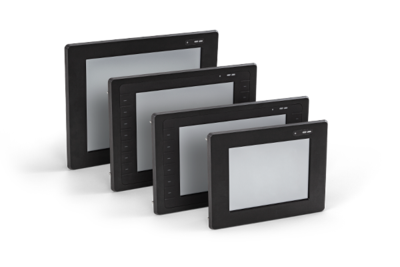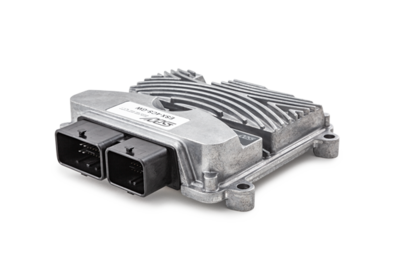JENZ is renowned for its high-quality chippers, used for chopping up shrubbery and heavy tree trunks, as well as for its top-class biomass processors. The company offers very different sizes and performance classes of vehicles and machines. In order to satisfy the increasing demands on the scalability across these classes as well as on user-friendliness, parameterization, configuration, expandability and performance, JENZ has introduced new displays from the VSX family by Sensor-Technik Wiedemann (STW) into their products.
JENZ had been looking for a new product representative of the next generation of display control units, which combines a high level of robustness with high performance, and which could be used in different sizes for all construction series. It had to be possible to install these displays both into a cabin and into a control cabinet, and they should be available both with and without keys. Weiss Mobiltechnik GmbH, as a long-standing electronics development partner of JENZ, and specialists in display programming, control units and telemetry, suggested the new VSX display product series by STW. One important aspect from Weiss‘ point of view was the further development of the display software established at JENZ. It should be possible to continue use of the existing software, and to add new functions without much effort.
The VSX family offered the optimum prerequisites for these requirements. Linux and the GUI Toolkit QT are available in the standard version of this display with its Cortex A9 Dual-Core processor. In order to support Weiss, STW also implemented a CODESYS 3.5 runtime system on Linux. The interfaces between the CODESYS runtime system and QT on the one hand, and the graphic library by Weiss on the other were implemented in a special “wrapper layer”. This now permits Weiss to utilize its graphics library and all the applications based upon it immediately on the STW displays without source code adaptations or other changes being required.
For the first project, Weiss used the VSX-10 Professional Display for the cabin of the HEM 821 DQ Cobra+ hybrid chipper. In combination with an operating console, all the HEM 821 functions can be controlled here. The HEM 821 is a compact 4-axle-truck 8x6-4 with steered trailing axle for extreme off-road capabilities and high maneuverability. The rotatable and elevating driver’s cabin provides an optimum overview, making it possible to change trucks at the location of operation even when the cabin is rotated and elevated and with the carrier vehicle under full tractive power. The chipper is suitable for shrubbery and heavy tree trunks up to diameters of approx. 800 mm, and permits high-performance chipping in extreme, continuous operations.
The display plays a central role in the HEM 821. Individual settings can be undertaken for the driver in different display menus. The operating elements are implemented as sliders or buttons. Limit values such as the maximum motor speeds can be defined in configuration menus, or certain advance selections can be made regarding working conditions or user profiles. Other menus permit the extension and retraction of the supports, the position regulation of the cabin itself, or depict work functions such as the speed control of the conveyor belt or the operation of the crane via touchscreen or buttons. It is therefore always possible to optimize the machine settings, and thus to guarantee maximum economic viability. Up to 2000 continuously-changing parameters including J1939 engine data, such as the speed or current fuel consumption are shown in special diagnosis menus using various display instruments. The high level of brightness also permits good legibility in direct sunlight. Regarding the presentation, the operator also profits from the high performance capability of the display. Menu changes take place spontaneously; the display instruments run jerk-free so that pleasant operation with immediate feedback is possible.
The communication with the control units, in which in turn the work function is implemented using control and regulation algorithms, takes place via the CAN Bus. The Professional version of the VSX-10 offers 4 CAN Bus interfaces, meaning that different buses are connected and gateway functions can also be implemented. It is even possible to wake up the display via defined CAN Bus messages. The control units used are the STW ESX-3CM for the chipper itself and the STW ESX-2-4 for the crane.
Furthermore, the control units and the display can be connected with a combined datalogger / telematic module, the TC3G by STW. A series of functions has been implemented by Weiss in the freely programmable Embedded Linux available on this module. In this way, all operating data can be recorded and transmitted via USB, Wi-Fi or mobile communications into the company-specific data processing. Using the display enhancement possibilities, it is possible to depict this function, too, in the display itself.
In future, further JENZ vehicles are to be equipped with the VSX display. Here the family approach featuring different display sizes from 8“ to 15“ with the same platform is an advantage. Whereas the functionality does not have to be changed, the user interfaces can easily be adapted to the new dimensions through the Weiss graphic libraries. Regarding their use in control cabinets, not only the protection class IP67 is of benefit, but the resistive touchscreen also permits operation using gloves. “The typical utilization of the two CPU Cores“, says Mr. Mönninghoff from Weiss, “lies at maximum 20%”. This means that the display also provides sufficient space for new, improved algorithms, additional assessments and indications.



